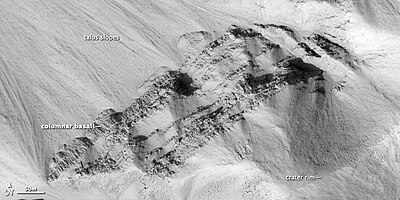Marte Vallis
 Marte Vallis based on THEMIS day-time image | |
| Coordinates | 15°00′N 176°30′W / 15°N 176.5°W |
|---|---|

Marte Vallis is a valley in the Amazonis quadrangle of Mars, located at 15 North and 176.5 West. It is 185 km long and was named for the Spanish word for "Mars".[2] It has been identified as an outflow channel, carved in the geological past by catastrophic release of water from aquifers beneath the Martian surface.[3] The surface material is thought to have been created out of 'a'ā and pāhoehoe lava flows from the Elysium volcanic province in the west.[4]
Marte Vallis is the site of the first discovery of columnar jointing on Mars.[1] Columnar jointing often forms when basalt lava cools.[5]
-
Streamlined Island in Marte Vallis, as seen by HiRISE. The enlarged image gives a good view of dark slope streaks. Island is just to the west of Pettit Crater. Scale bar is 500 meters long.
-
Layers in old crater rim, in Marte Vallis as seen by HiRISE under HiWish program
-
Close view of layers from previous image, as seen by HiRISE under HiWish program Some dark slope streaks are visible.
-
Columinar Jointing in Yellowstone National Park.
-
Columnar jointing in the basalt of the Giant's Causeway in Northern Ireland
References
Wikimedia Commons has media related to Marte Vallis.
- ^ a b Milazzo, M.P., Keszthelyi, L.P., Jaeger, W.L. Rosiek, M., Mattson, S., Verba, C., Beyer, R.A., Geissler, P.E., McEwen, A.S., and the HiRISE Team. (2009) Discovery of columnar jointing on Mars. Geology. 37(2), 171–174. Abstract
- ^ "Home". planetarynames.wr.usgs.gov.
- ^ Carr, M.H. (2006), The Surface of Mars. Cambridge Planetary Science Series, Cambridge University Press.
- ^ Voigt, Joana R. C.; Hamilton, Christopher W. (2018-07-15). "Investigating the volcanic versus aqueous origin of the surficial deposits in Eastern Elysium Planitia, Mars". Icarus. 309: 389–410. Bibcode:2018Icar..309..389V. doi:10.1016/j.icarus.2018.03.009. ISSN 0019-1035. S2CID 125918565.
- ^ Bates, R. and J. Jackson (eds.) 1976. Dictionary of Geological Terms. Doubleday, New York.
See also




